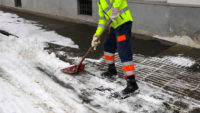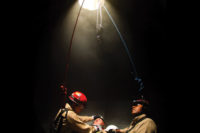The essential safety PPE your team needs for disaster preparedness

AlenaPaulus / E+ / Getty Images
It’s no secret – natural disasters have devastating effects. Whether it be a flood, wildfire or hurricane, these severe events can tear apart local communities, displace families and result in fatalities. For the first responders on the scene helping resolve or clean up the sites, there are significant dangers they need to be protected against. To best prepare for natural disasters before they take place, emergency response workers need to have the proper personal protective equipment (PPE) on hand to help keep them safe.
Head protection
When first responders enter damaged structures, they are exposed to a variety of overhead risks and falling objects. Because of these risks, proper and consistent use of hard hats is vital. When determining which type of hard hat to choose for best protection, options with lightweight, high-impact materials that provide a secure fit are recommended. In addition, workers should look for head protection with good quality suspension built into the support frame so that energy from an impact can be spread over the surface the hard hat.
Eye and face protection
In the aftermath of a disaster, work activity in dirty, damaged structures can cause particles such as dust and soot to become airborne — a major safety risk to workers’ eyes. To protect workers’ vision, they should opt for glasses or goggles with a sealed fit for protection against airborne debris.
Hand protection
As main points of contact in potentially hazardous situations or with dangerous substances, a worker’s hands deserve special safety consideration. Unfortunately, hand injuries such as cuts and lacerations are all-too-common. Chemicals, and even concrete, can pose a major threat to hands as well. Workers should select glove materials according to the specific protection required. No matter the use case that work gloves are intended for, all variations should have these important attributes: comfort, dexterity, grip and breathability. Gloves that are the wrong size, uncomfortable or inappropriate for the task are likely to be quickly discarded by the wearer — along with the protection they were intended to provide.
Foot protection
Disaster cleanup sites can be prone to floors and surfaces that are rough and uneven; muddy or slick with water, chemicals or liquids; or are otherwise hazardous. Workers’ feet can be exposed to risks including impact, crush, puncture, slipping injuries or even overall fatigue for the wearer. Proper safety footwear guards against these hazards while providing maximum support. When selecting safety footwear, consider options with high flexibility and durability featuring a protective toe cap, steel midsole and ankle protection to protect from falling debris or puncture risks; enhanced slip resistance on the sole; and a self-cleaning tread design.
Respiratory protection
Physical injuries are not the only hazards in a cleanup effort. It is important to protect the lungs because various gases, toxic chemicals, fumes and particles can remain in the air long after a catastrophic event has passed. Asbestos and silica are a cause of poor health on the job site, often inhaled as dust during demolition and refurbishment activities, so respiratory protection is strongly advised. Single use, reusable face masks, half-face or full-face respirators or ventilated hoods are available to prevent inhalation of dangerous substances.
Hearing protection
In the days and weeks following a storm or fire, power tools, equipment and heavy machinery are brought in to help clear the site. This can mean worksites are enveloped by loud noises, which can increase risk of permanent, noise-induced hearing loss.
Effective hearing protection reduces the level of sound exposure to permissible limits while allowing users to maintain real-time personal communication and situational awareness for their personal efficiency and safety. There are many options for hearing protection. Selection factors include noise exposure and desired protection levels, product type (earplug or earmuff) and style (single/multiple uses, banded, etc.). Training and testing before use helps users ensure the proper fit of the hearing protector and the desired level of protection.
Electrical safety
Structurally damaged facilities pose multiple electrical hazards that require a full array of PPE. Utility and electrical workers must protect themselves by wearing rubber insulating gloves with leather protectors, and head protection including face shields and hard hats. The first order of business is to cut electrical power to the severely affected area, allowing first responders to sweep through and begin the assembly of the new infrastructure. Even when electrical equipment is turned off, it can become temporarily re-energized, for example during an electrical storm. Qualified workers near energized equipment or downed power lines must wear arc flash protective clothing, dielectric boots and overshoes, rubber insulating gloves, hard hats and face shields.
It takes a head-to-toe approach to keep first responders safe
Preparation for natural disasters means not only having the right safety procedures in place before a severe event, but also having the proper protective equipment for the cleanup afterwards. Even after a fire has been put out or a hurricane has passed and the site has been cleared for re-entry, many dangers remain for workers involved in cleanup operations. Every first responder will tell you that there is no simple way to clean disaster sites but having the proper PPE can help keep emergency workers safe while they are on the front lines.
Looking for a reprint of this article?
From high-res PDFs to custom plaques, order your copy today!








